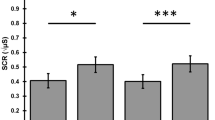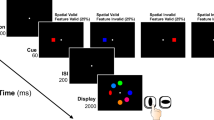Abstract
The evoked cardiac response (ECR) of heart rate deceleration, respiratory pause, the peripheral pulse amplitude response (PPAR) of vascular constriction, and the galvanic skin response (GSR) were recorded from 20 subjects presented with a series of brief target and nontarget stimuli in a random order. Prestimulus vigilance was equivalent for the two types of stimuli since each had to be identified as target or nontarget before being processed, or ignored, respectively. This difference in signal value following identification affected only the GSR, supporting a conceptualization of preliminary processes in orienting response (OR) elicitation rather than Sokolov’s unitary OR concept.
Similar content being viewed by others
References
Barry, R. J.: Low intensity auditory stimuli and the GSR orienting response.Physiological Psychology, 5:98–100, 1975.
Barry, R. J.: Failure to find the “local” EEG OR to low-level auditory stimulation.Physiological Psychology, 4:171–174, 1976.
Barry, R. J.: Failure to find evidence of the unitary OR concept with indifferent low-intensity auditory stimuli.Physiological Psychology, 5:89–96, 1977a.
Barry, R. J.: The effect of “significance” upon indices of Sokolov’s orienting response: A new conceptualization to replace the OR.Physiological Psychology, 5:209–214, 1977b.
Barry, R. J.: Disruption of sinus arrhythmia and its relation to the classification of non-habituating OR measures.Physiology and Behavior, 21:25–27, 1978a.
Barry, R. J.: Physiological changes in a reaction-time task: Further problems with Sokolov’s dimension of stimulus “significance.”Physiological Psychology, 6:438–444, 1978b.
Barry, R. J.: A factor analytic examination of the unitary OR concept.Biological Psychology, 8:161–178, 1979.
Barry, R. J., and James, A. L.: Fractionation of phasic responses in a dishabituation paradigm.Physiology and Behavior, 26:69–75, 1981.
Barry, R. J., and James, A. L.: Fractionation of respiratory and vascular responses with simple visual stimulation.Physiological Psychology (In press).
Becker, D. E., and Shapiro, D.: Directing attention towards stimuli affects the P300 but not the orienting response.Psychophysiology, 17:385–389, 1980.
Bernstein, A. S.: The orienting response as noveltyand significance detector: Reply to O’Gorman.Psychophysiology, 16:263–271, 1979.
Furedy, J. J., and Arabian, J. M.: A Pavlovian psychophysiological perspective on the OR: The facts of the matter. In H. D. Kimmel, E. H. van Olst, and J. F. Orlebeke (Eds.):The Orienting Reflex in Humans. Hillsdale, N. J.: Lawrence Erlbaum Associates, 1979.
Ginsberg, S., and Furedy, J. J.: Stimulus repetition, change and assessments of sensitivities of and relationships among an electrodermal and two plethysmographic components of the orienting reaction.Psychophysiology, 11:35–43, 1974.
Graham, F. K.: Habituation and dishabituation of responses innervated by the autonomic nervous system. In H. V. S. Peeke and M. J. Herz (Eds.):Habituation. New York: Academic Press, 1973.
Groves, P. M., and Thompson, R. F.: Habituation: A dual-process theory.Psychological Review, 77:419–450, 1970.
James, A. L., and Barry, R. J.: Respiratory and vascular responses to simple visual stimuli in autistics, retardates and normals.Psychophysiology, 17:541–547, 1980.
Kahneman, D.:Attention and Effort. Englewood Cliffs, N. J.: Prentice-Hall, 1973.
Maltzman, I.: Orienting reflexes and significance: A reply to O’Gorman.Psychophysiology, 6:274–282, 1979.
Maltzman, I., Gould, J., Barnett, O. J., Raskin, D. C., and Wolf, C.: Habituation of the GSR and digital vasomotor components of the orienting reflex as a consequence of task instructions and sex differences.Physiological Psychology, 7:213–220, 1979.
van Olst, E. H., Heemstra, M. L., and ten Kortenaar, T.: Stimulus significance and the orienting reaction. In H. D. Kimmel, E. H. van Holst, and J. F. Orlebeke (Eds.):The Orienting Reflex in Humans. Hillsdale, N. J.: Lawrence Erlbaum Associates, 1979.
Poor, D. D. S.: Analysis of variance for repeated measures designs: Two approaches.Psychological Bulletin, 80:204–209, 1973.
Ray, R. L., Piroch, J. F., and Kimmel, H. D.: The effect of task and stimulus variability on habituation of electrodermal and vasomotor reactions.Physiological Psychology, 5:189–196, 1977.
Siddle, D. A. T., and Heron, P. A.: Effects of length of training and amount of tone intensity change on amplitude of autonomic components of the orienting response.Australian Journal of Psychology, 29:7–16, 1977.
Sokolov, E. N.: The higher nervous activity and the problem of perception.Acta Psychologica, 13:134–135, 1955.
Sokolov, E. N.: Neuronal models and the orienting reflex. In M. A. Brazier (Ed.):The Central Nervous System and Behavior. New York: Macey, 1960.
Sokolov, E. N.:Perception and the Conditioned Reflex. Oxford: Pergamon Press, 1963.
Author information
Authors and Affiliations
Rights and permissions
About this article
Cite this article
Barry, R.J. Signal value and preliminary processes in or elicitation. Pav. J. Biol. Sci. 16, 144–150 (1981). https://doi.org/10.1007/BF03003219
Issue Date:
DOI: https://doi.org/10.1007/BF03003219




